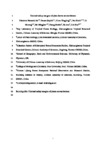Thermal safety margins of plant leaves across biomes under a heatwave
| dc.contributor.author | Kitudom, N | |
| dc.contributor.author | Fauset, S | |
| dc.contributor.author | Zhou, Y | |
| dc.contributor.author | Fan, Z | |
| dc.contributor.author | Li, M | |
| dc.contributor.author | He, M | |
| dc.contributor.author | Zhang, S | |
| dc.contributor.author | Xu, K | |
| dc.contributor.author | Lin, H | |
| dc.date.accessioned | 2022-11-29T11:50:22Z | |
| dc.date.issued | 2022-02 | |
| dc.identifier.issn | 0048-9697 | |
| dc.identifier.issn | 1879-1026 | |
| dc.identifier.other | 150416 | |
| dc.identifier.uri | http://hdl.handle.net/10026.1/20029 | |
| dc.description.abstract |
Climate change has great impacts on forest ecosystems, especially with the increasing frequency of heatwaves. Thermal safety margin (TSM) calculated by the difference between body temperature and thermotolerance threshold is useful to predict thermal safety of organisms. It has been widely used for animals, whereas has rarely been reported for plants. Besides, most of the previous studies used only thermotolerance to estimate thermal safety or used thermotolerance and air temperature (Ta) to calculate TSM. However, leaf temperature (Tl) is the real "body" temperature of plant leaves. Tl decoupling from Ta might induce large error in TSM. Here, we investigated TSM of photosystem II (thermotolerance of PSII - the maximum Tl) of dominant canopy plants in four forests from tropical to temperate biomes during a heatwave, and compared the TSMs calculated by Tl (TSM.Tl) and Ta (TSM.Ta) respectively. Also, thermal related leaf traits were investigated. The results showed that both TSM. Tl and TSM.Ta decreased from the cool forests to the hot forests. TSM.Tl was highly correlated with the maximum leaf temperature (Tlmax), while had an opposite trend with thermotolerance across biomes. Thus, Tlmax instead of thermotolerance can be used to evaluate TSM. The maximum Ta (Tamax), Tlmax and leaf traits explained 68% of the variance of thermotolerance in a random forest model, where Tamax and Tlmax explained 62%. TSM.Ta could not distinguish thermal safety differences between co-occurring species. The overestimation of TSM by TSM.Ta increased from the tropical to the temperate forest, and increased with Tl within biome. Therefore, it is not recommended to use TSM.Ta in cold forests. The present study enriches the dataset of photosynthetic TSMs across biomes, proposes using Tlmax to estimate TSMs of leaves, and highlights the risk of hot dry forest during heatwaves. | |
| dc.format.extent | 150416-150416 | |
| dc.format.medium | Print-Electronic | |
| dc.language | en | |
| dc.language.iso | eng | |
| dc.publisher | Elsevier BV | |
| dc.subject | Photosynthetic heat tolerance | |
| dc.subject | Thermal environment | |
| dc.subject | Heat stress | |
| dc.subject | Thermal stability | |
| dc.subject | Extreme weather | |
| dc.title | Thermal safety margins of plant leaves across biomes under a heatwave | |
| dc.type | journal-article | |
| dc.type | Journal Article | |
| plymouth.author-url | https://www.webofscience.com/api/gateway?GWVersion=2&SrcApp=PARTNER_APP&SrcAuth=LinksAMR&KeyUT=WOS:000707640400017&DestLinkType=FullRecord&DestApp=ALL_WOS&UsrCustomerID=11bb513d99f797142bcfeffcc58ea008 | |
| plymouth.issue | Pt 2 | |
| plymouth.volume | 806 | |
| plymouth.publication-status | Published | |
| plymouth.journal | Science of The Total Environment | |
| dc.identifier.doi | 10.1016/j.scitotenv.2021.150416 | |
| plymouth.organisational-group | /Plymouth | |
| plymouth.organisational-group | /Plymouth/Faculty of Science and Engineering | |
| plymouth.organisational-group | /Plymouth/Faculty of Science and Engineering/School of Geography, Earth and Environmental Sciences | |
| plymouth.organisational-group | /Plymouth/REF 2021 Researchers by UoA | |
| plymouth.organisational-group | /Plymouth/REF 2021 Researchers by UoA/UoA06 Agriculture, Veterinary and Food Science | |
| plymouth.organisational-group | /Plymouth/Users by role | |
| plymouth.organisational-group | /Plymouth/Users by role/Academics | |
| dc.publisher.place | Netherlands | |
| dcterms.dateAccepted | 2021-09-14 | |
| dc.rights.embargodate | 2023-2-1 | |
| dc.identifier.eissn | 1879-1026 | |
| dc.rights.embargoperiod | Not known | |
| rioxxterms.versionofrecord | 10.1016/j.scitotenv.2021.150416 | |
| rioxxterms.licenseref.uri | http://www.rioxx.net/licenses/all-rights-reserved | |
| rioxxterms.licenseref.startdate | 2022-02-01 | |
| rioxxterms.type | Journal Article/Review |


